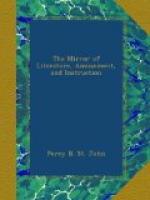Of Tunbridge Wells, as an olden and modern resort, we have very recently spoken,[6] and we are happy to perceive that the association of the place with the literary characters of the last century, as pleasantly recorded by Samuel Richardson, has been turned to interesting account in the pages before us. Cumberland, the dramatist, we omitted to mention, not only resided for some years, but wrote many of his works, at Tunbridge Wells: and here he recognised the sterling talent of Dowton, the comedian, who, through Cumberland, was first introduced to the London stage. “One of the houses at Mount Ephraim, (at the Wells,) adjoining the Tunbridge Ware manufactory, formerly belonged to the infamous judge Jeffries;” and an adjoining house was built by Sir Edmund King, physician to Charles II., and his frequent residence here probably attracted the court. The antiquities of the environs are very attractive. On a lofty knoll are the remains of an ancient encampment, called Saxon-bury Castle, from its name, ascribed to the Saxons; a neighbouring spot bears the name of Dane’s Gate, and is supposed to be part of an old trackway or military road. “On Edridge Green continued, for many years, a curious mortar or large gun, said to have been the first made in England. The tradition is that it was cast at Buxted furnace about twelve miles north of Lewes. It is preserved in the British Museum; and some account of it, with a print, is given in the Archaeologia, vol. x. p. 472.” Next is the estate of Edridge, among the lords of which were Godwin, Earl of Kent and the Earl of Montaigne and Cornwall: Mayfield, was possessed by the see of Canterbury before the Norman conquest, and at its palace Sir Thomas Gresham lived in sumptuous style, and probably entertained Queen Elizabeth in one of her progresses; among the curiosities here the anvil, hammer, and tongs, which are traditionally said to have belonged to the noted St. Dunstan, “and, who is also said to have used the last instrument most ungallantly, and even brutishly, in twinging the nose of Old Nick, who tempted the immaculate prelate in the form of a fine lady;” Bayham, or Bageham Abbey, about 6 miles south-east of the Wells, was a monastery of great extent in 1200, but is now so dilapidated and overgrown as scarcely to enable the antiquary to trace its architectural features: here too is an immense pollard ash-tree, which Gough describes, in his additions to Camden’s Britannia, as being “several yards in girth, as old, if not older, than the abbey, and supposed to be the largest extant.” Mr. Britton likewise noticed here a curious instance of ivy, which has not only covered nearly the whole surface of the (abbey) building, but has insinuated its treacherous branches into the joints and crevices of the masonry. “The wood,” says our observant author, “has grown to a great size, and displaced columns, mouldings, mullions, &c. and thus overturned and destroyed the very objects it was intended to adorn.”




